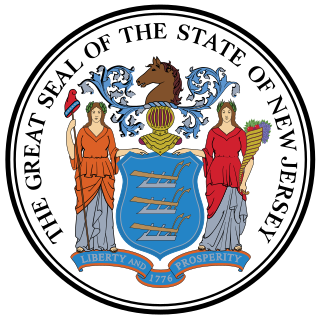History
West Jersey was first divided into ten shares when Edward Byllynge and John Fenwick sold parts of their shares to others in order to defray debts. Byllynge, William Penn, Gawen Lawrie and Nicholas Lucas retained nine tenths of the province, with Fenwick retaining one tenth. [1] Fenwick's tenth would eventually evolve into Salem County.
Edward Byllynge was a British colonial administrator and governor of West New Jersey from 1680 to 1687, until his death in England. Byllynge owned a large section of land in New Jersey with the Quakers.
John Fenwick (1618–1683) was the leader of a group of Quakers who emigrated in 1675 from England to Salem, New Jersey where they established Fenwick's Colony, the first English settlement in West Jersey.

William Penn was the son of Sir William Penn, and was an English nobleman, writer, early Quaker, and founder of the English North American colony the Province of Pennsylvania. He was an early advocate of democracy and religious freedom, notable for his good relations and successful treaties with the Lenape Native Americans. Under his direction, the city of Philadelphia was planned and developed.
Tenths were formally established by the Lords Proprietors of West New Jersey under "The Concessions and Agreements of the Proprietors, Freeholders and Inhabitants of the Province of West New Jersey, in America", approved March 3, 1676/77, which provided for "dividing all the lands of the said Province, as be already taken up, or by themselves shall be taken up and contracted for with the natives; and the said lands so taken up and contracted for, to divide into one hundred parts, as occasion shall require; that is to say, for every quantity of land that they shall from time to time lay out to be planted and settled upon, they shall first for expedition divide the same into ten equal parts or shares". [2]
In February 1681 "The Methods of the Commissioners for settling and regulation of Lands" directed that each tenth was to contain 64,000 acres, and to "have their proportion of front to the river Delaware". [3] Only five of the tenths were actually organized.

The Delaware River is a major river on the Atlantic coast of the United States. It drains an area of 14,119 square miles (36,570 km2) in five U.S. states: Delaware, Maryland, New Jersey, New York, Pennsylvania. Rising in two branches in New York state's Catskill Mountains, the river flows 419 miles (674 km) into Delaware Bay where its waters enter the Atlantic Ocean near Cape May in New Jersey and Cape Henlopen in Delaware. Not including Delaware Bay, the river's length including its two branches is 388 miles (624 km). The Delaware River is one of nineteen "Great Waters" recognized by the America's Great Waters Coalition.


